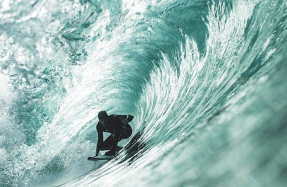OF WAVES AND WHITE ELEPHANTS

Between the Northern Baja cities of Rosarito and Ensenada lies a stretch of coast wholly unrelated to either municipality. For the traveler heading south on Mexican Federal Highway 1, on crossing a bridge at the south end of La Fonda, this stark region of agave and yucca appears to ascend, rising to a small rancho called Salsipuedes and ending in a slow descent as one approaches the last tollbooth before the port of Ensenada. Visitors have called it the Big Sur of Baja California, as corniced summits of red rock cascade into headlands and on to the sea itself. Like its Alta California counterpart, the highway feels tenuously secured to occasional perches, a thread floating between the peaks above and the depths below. The feeling of vulnerability this inspires is not without merit. The terrain is sheer and unstable. Massive sections have detached, taking out lengths of Highway 1 before crumbling to the water’s edge.
Surfers have made pilgrimages along this coast to points farther south for 60 years. In the 1960s, old-timers have claimed, intrepid surfers would slide a few at Punta San Miguel (the site of the Baja Surf Club Invitational, and now within view of the Ensenada tollbooth), pack up, head north and eventually dip their boards into the breakers of Rincon all in a single day. Traffic, development and the border industrial complex have made such a feat all but impossible today.
Those same forces may have allowed the Costa Azul region to remain raw while other parts of Baja have been tamed. The terrain’s inhospitality, of course, certainly lent another layer of protection. The name of the zone’s extremely fickle pointbreak translates to “get out if you can.”
The dramatic scale of the coast seemed to obscure potential waves in plain view. Although members of the La Jolla Surf Club day-tripped to Todos Santos in 1965, visible just 8 miles off the coast, its big-wave break, Killers, wasn’t regularly challenged until the mid-’80s.
Two decades later, that feeling of untapped discovery may as well have been riding shotgun with photographer Jason Murray and surfers Rusty and Greg Long as they made their initial forays into the region. Rusty was just a year out of high school. His younger brother Greg was months away from winning the NSSA National Open Men’s title at Trestles, an event that would change both of their lives. Rusty described
You’re reading a preview, subscribe to read more.
Start your free 30 days





